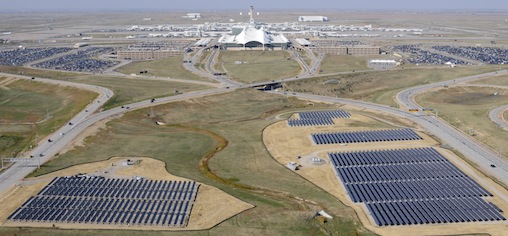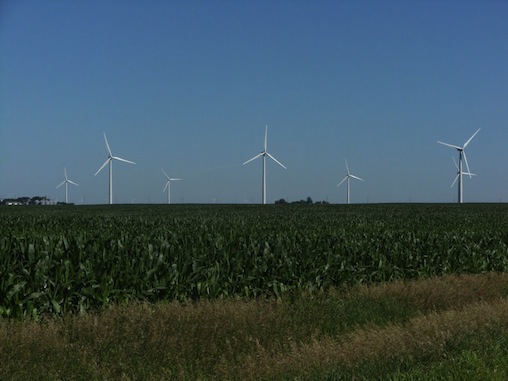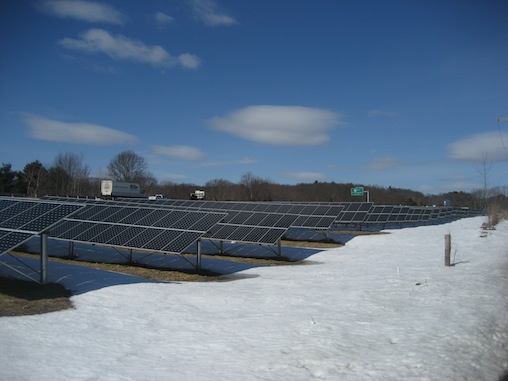Microsoft is building a data center next to a Wyoming landfill in order to use its methane gas to power the facility.
Apple now uses a massive 100-acre solar energy farm to power its Maiden, N.C., data center.
And Google has placed data centers in Oklahoma and Iowa so they can plug into wind farms.
America's top tech companies are going green in a big way, so much so that the availability of clean energy resources is now a key consideration in where they locate corporate offices and data centers. The move is designed to save them millions of dollars in long-term energy costs.
"We believe energy is the future of our business," said Josh Henretig, director of environmental sustainability at Microsoft.
"Microsoft has increasingly transitioned from a software company to a services and devices company," said Henretig. "The services are largely based on our need for cloud [infrastructures] and, in turn, the energy that those clouds and data centers use. So we are absolutely focused on the role energy plays in our organization longer term."
Massive renewable growth
Over the past six years, the growth in wind farm deployments in the U.S. has been second only to gas-powered electrical plants.
According to the latest data, 6.8 gigawatts of wind power was added in the U.S. in 2011, a 31% increase over 2010. That 2011 jump brought the cumulative wind power capacity for the U.S. to 47 gigawatts, according to a study published by the Lawrence Berkeley National Laboratory.
The latest data from the Solar Energy Industries Association (SEIA) shows that the U.S. now has more than 6.4 gigawatts of installed solar electric capacity, enough power for more than a million households. And, while the numbers aren't in yet, 2012 was expected to be a record year for more growth, according to the SEIA.
Dan Shugar, an SEIA board member, said that when he first entered the solar energy industry 25 years ago as an electrical engineer, the world's collective solar arrays produced only about .03 gigawatts of power. Today, they produce 30 gigawatts (a gigawatt is a billion watts).
"That's a 1,000 times increase over my career. It's unstoppable," Shugar said.
The list of companies using and deploying renewable energy resources includes Intel, Kohl's, Staples, Wal-Mart, Ikea, McDonalds, Walgreens, Macy's, FedEx, Toyota and Lockheed Martin, according to the U.S. Environmental Protection Agency (EPA).

Onsite solar power arrays are becoming more common and visible, like this one at the Denver International Airport that takes up seven acres and provides 2 million watts of power.
A greener Google
In 2011, the EPA awarded Google the Green Power Partner of the year award.
Google has pledged to reduce its carbon footprint to zero through energy efficiency and by purchasing carbon-free renewable electricity to power its data centers and corporate facilities.
Currently, a third of Google's energy consumption comes from renewable energy -- 13% from utility companies and the remaining 20% from wind and solar facilities owned by Google or a third party.
In 2007, Google constructed a 1.7-megawatt solar farm for its central facilities in Mountain View, Calif. The cost of that project, which has not been disclosed, was expected to produce return on investment (ROI) within seven years through cost savings. It's now on target to beat that projection and see ROI this year, according to Gary Demasi, Google's director of Global Infrastructure.
From this year forward, the solar power facility will continue to produce about 3 million kilowatt hours of power per year, saving the company in energy costs while reducing its carbon footprint.
In 2011, Google signed two 20-year contracts to purchase all the power from wind farms in Iowa and Oklahoma for two of its data centers in those states. The first contract was for 114 megawatts of wind generation from NextEra's Story County II facility in Iowa; the second was for 100.8 megawatts of wind generation from NextEra's Minco II facility in Oklahoma.

NextEra wind farm in Oklahoma (Source: NextEra)
Last year, Google signed a separate wind power purchase agreement with the Grand River Dam Authority to power the company's Mayes County, Okla., data center with 48 megawatts of wind energy from the Canadian Hills Wind project.
"We've also done some methane capture projects on some landfills in the U.S., thereby reducing the amount of carbon released into the atmosphere," Demasi said.
Large-scale data centers and corporate facilities can use tens of millions of watts of electricity and they require a steady, reliable power source. While both wind and solar are intermittent power sources, solar has an advantage over windmills -- even if wind power is steadier.
"The nice thing with solar is it produces energy when your data centers are at peak power rates, during the middle of the day when it's super hot inside," Demasi said.
Renewable premium
While Google has made a significant dent in its power requirements with renewable energy, green power projects such as the Grand River Dam Authority windmill farm cost more than brown, or polluting, energy resources.

"In places where we're procuring renewable energy through a utility ... we're paying a slight premium for that power, but it's worth it to the company because we've determined that small premium we pay is financially reasonable," Demasi said.
"It's tough to procure renewable energy at equal to or less than what you can buy power off the grid," he continued. "So you've got to have a corporate appetite for that premium. The founders and leaders of the company believe we should do the right thing for the environment. That's definitely a clear mandate."
By pumping money into renewable energy resources, Google also hopes to drive up the economies of scale in order to eventually push prices below that of brown energy resources, Demasi said.
According to the U.S. Energy Information Administration, utility-scale wind projects cost about $2 per watt to install, and solar projects are about $3 per watt. Using those figures, a 100-megawatt wind project would cost about $200 million; a similar solar facility would cost about $300 million.
Independent power producers such as NextEra and Invenergy own more than 80% of all wind power capacity installed in the U.S. The same is true for solar power.
Dropping prices
The median installed price of solar photovoltaics has dropped by 25% to 35% over the past three years, according to a study published by the Lawrence Berkeley National Laboratory in November 2012.
The cost for solar electricity dropped by $2.1 per watt from 2008 through 2011, according to Lawrence Berkeley National Labs.
The study, which includes preliminary data for 2012, included data based on more than 150,000 individual residential, commercial and utility-scale photovoltaic systems, totaling more than 3,000 megawatts and representing 76% of all grid-connected photovoltaic capacity in the U.S.
According to the study, the median installed price in 2011 was $6.1 per watt for systems less than 10 kilowatts in size; $5.6 per watt for systems between 10 and 100 kilowatts in size; and $4.9 per watt for systems offering more than 100 kilowatts. Prices for 2012 are not yet available.
But partial data for the first six months of 2012 indicate that prices continue to fall, with the median installed price of projects last year 3% to 7% cheaper than in 2011.
The installed price of solar power has dropped even more in states such as Massachusetts, where incentives for renewable energy have placed the state ahead of the rest of the country in solar deployments.
According to the Lawrence Berkeley Lab study, the market for photovoltaic power in the United States is, to a significant extent, driven by national, state and local government incentives, including up-front cash rebates, production-based incentives, renewables portfolio standards and federal and state tax benefits.
For example, the price for solar power deployments in Massachusetts now costs an average of $4 per watt, down from $12 in 1998, according to Carrie Cullen Hitt, senior vice president of state affairs for the Washington-based SEIA.
While Massachusetts is ranked 44th in size among the other 50 states, the Bay State is ninth in solar energy deployment, mostly due to aggressive state government incentive programs.

To date, Massachusetts corporations have deployed 200 megawatts of solar power and utilities have deployed another 50 megawatts, according to Hitt. Yet, solar power still only makes up about 1.5% of the state's 13,000 megawatts of power generation.
At the federal level, the IRS's Investment Tax Credit (ITC) is still considered the big dog among incentive programs for using renewable energy. While not specific to renewable energy, the ITC offers companies a 30% tax credit for renewable power investments.
Remarkable growth
Just seven years ago, deploying a one-megawatt solar array was considered a huge accomplishment. Companies today, however, are regularly deploying systems that are 100 times larger, according to the Shugar.
For example, Apple last year completed a 100-megawatt solar farm for its North Carolina data center. A fuel cell facility capable of storing five megawatts of electricity will support the solar farms.
At full capacity, Apple's data center will draw about 20 megawatts of power.
"While we'll produce 60% of the power used by our Maiden data center onsite, we'll meet the remaining 40% of our energy needs by directly purchasing clean, renewable energy generated by local and regional sources," said Apple spokesman Nick Leahy.
Apple rival Microsoft is one of the largest purchasers of green power in the U.S. The EPA recently recognized it as the third largest purchaser of green power in the U.S., buying up more than 1.1 billion kilowatt-hours of green power a year.
Microsoft has been dabbling in renewable energy for more than a decade.
In 2004, it installed what at the time was Silicon Valley's largest solar power system, which produced 480 kilowatts at peak capacity. The solar farm was composed of 2,288 tiles, and today offsets as much as 15% of Microsoft's energy needs at a five-building campus with about 1,800 workers, according to Microsoft spokesman Doug Free.
The company is now exploring using biogas from landfills to power its facilities. Last fall, Microsoft's Global Foundation Services Group, which runs the company's cloud services and data centers, unveiled a data center that will run on biogas produced by a local Wyoming landfill and water treatment facility. The "mini-data center" will use 200 kilowatts coming from the biogas facilities, said Henretig.
But Microsoft's largest investment has been in hydroelectric energy because the company's headquarters, and 60% of its operations, is located in the Puget Sound region of Washington state.
About 46% of the energy used by Microsoft's Redmond, Wash., campus comes from hydroelectricity, and most of the power for its data center in Quincy, Wash., is from hydropower generated in the Columbia River Basin. That alone put Microsoft in the No. 3 spot on the EPA's top 50 green companies in 2012.
At the top of the list was Intel. Officials there declined to speak about Intel's renewable energy program.
The carrot and the stick
Microsoft said what really sets it apart is its carbon fee. The fee, implemented last July, is a charge-back model to business divisions that use energy that produces carbon emissions.
Microsoft's business groups were told they must build into their budgets the price of carbon emissions for the energy they use.
The business divisions pay a carbon fee for each metric ton of carbon emissions associated with the operation of data centers, software development labs, office buildings and employee air travel. The carbon fee goes into a central fund used to purchase renewable energy and carbon offsets to achieve net carbon neutrality.
The charge-back model makes the company's business divisions responsible for the cost of offsetting the carbon emissions, Henretig said.
It also forces business units to include carbon in their long-term cost plans and figure out how to not only reduce the amount of energy they require, but how to make investments that will lead to the transition to cleaner sources of energy.
"We are trying to push accountability out within the company to the point of use," said Henretig, who would not disclose the fee Microsoft charges divisions for carbon emissions.
Unlike Microsoft, Google reduces its carbon emissions through the use of carbon credit offsets -- investing in an activity that reduces carbon emissions elsewhere when renewable energy isn't available.
The carbon credit is verified by a third party, and it signifies that greenhouse gas emissions are lower than they would have been had no one invested in the offset. One credit equals one metric ton of carbon dioxide prevented from entering the atmosphere, according to Google.
For example, if a Google data center is located in a region without renewable energy, Google would invest in renewable energy in another region that may not even effect its facilities directly.
"The deals we enter into, you can be assured we've done internal analytics to ensure it meets our cost thresholds," Demasi said.

The U.S. military's efforts
Along with large corporations, the U.S. military is turning out to be one of the largest deployers of renewable energy.
Last month, the U.S. Army installed its largest solar power farm to date at the White Sands Missile Range in New Mexico.
The solar array, which cost $16.8 million, is a 4.46 megawatt ground-mounted system composed of Solaria solar modules that were deployed by Siemens. The White Sands Missile Range solar energy system will take up two acres of land and will generate approximately 10 million kilowatt-hours of clean electricity annually. That's enough to save an estimated $930,000 a year.
Complemented by a 375-kilowatt solar carport for employees, the solar array at White Sands will supply approximately 10% of the total power used at the installation and reduce carbon emissions by 7,400 tons per year.
"When talking hundreds of megawatts, you're talking about covering quite a bit of space," said SEIA's Hitt.
Aided by tax incentives, the increase in solar deployments can be attributed to a sharp drop in installed system prices. Solar efforts are getting cheaper for two reasons: an improvement in silicon wafer production and economies of scale.
Photovoltaic power technology advances
SEIA's Shugar, who is also CEO of solar voltaic installer Solaria, said the technology to make the crystalline silicon wafers used for photovoltaic cells has improved exponentially over the past few decades.
The silicon wafering process begins with solid ingots made of single-crystal or multi-crystalline silicon material.
Thirty years ago, blocks of silicon ingots were sliced into thin wafers by hand using expensive and inefficient diamond saws, much in the same way a butcher slices cold cuts. The relatively thick wafers were then used to make photovoltaic cells.
In the 1980s, the solar industry began using wire saws to cut the ingots into wafers. Each slice was 500 microns in thickness (a micron is 1/1,000 of a meter). Historically, every five years, silicon wafer production has seen a 50-micron reduction in thickness. Today, wire saws slice an entire block into wafers at the same time, each wafer being only 150 microns in thickness, Shugar said.
Because of cost reductions, Shugar said solar deployments have grown by 50% to 100% every year for the past 12 years.
"It really is a technology story at the end of the day," Shugar said.
Major challenges ahead
Even with the advances in technology, Google's Demasi said there are still major challenges ahead, not the least of which is the intermittent nature of renewable energy and delivery hurdles.
For example, "smart grids," or electrical grids that are controlled by computers and measure the amount of electricity going out to businesses as well as the surplus green power being sold back to a utility, are still in their infancy.
Demasi said getting utilities to play the middleman role and deliver the renewable product Google wants is not always possible because green power resources are still limited.
Coal-fired power plants are still the single largest producer of electricity for corporations, but that is changing, according to Hitt. Five years ago, coal-fired power plants produced 52% of the nation's industrial energy supply. Today, they produce just 30%, she said.
Renewable energy still makes up just 9.1% of the power produced in the U.S., according to the Energy Information Administration.
"The holy grail is a low-cost resource delivered to the end user by the utility but that's also scalable to a company's needs," Demasi said. "Our ambition is to be 100% green as we grow, but that's a daunting challenge...."




